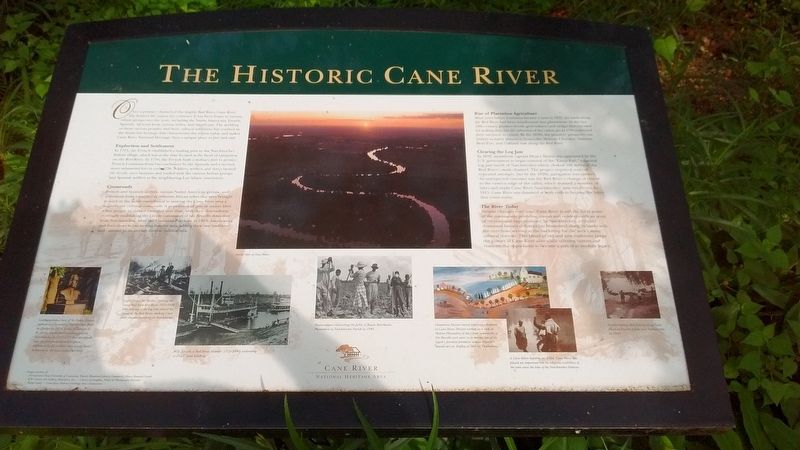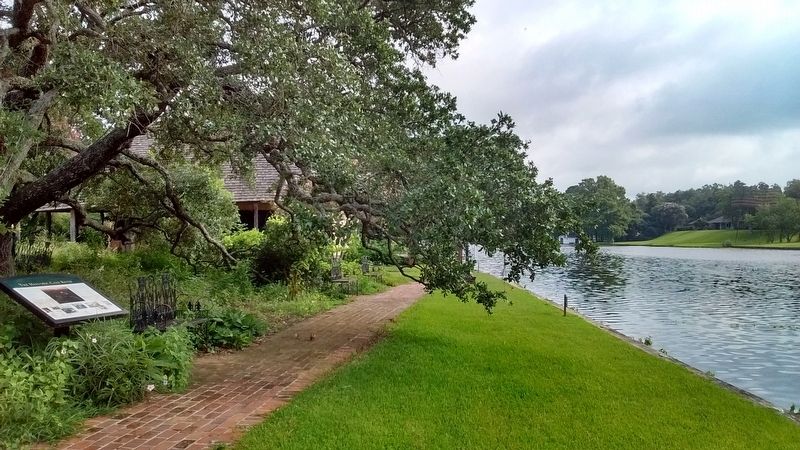Natchitoches in Natchitoches Parish, Louisiana — The American South (West South Central)
The Historic Cane River
Exploration and Settlement
In 1713, the French established a trading a post in the Natchitoches Indian Village, which was at the time located at the head of navigation on the Red River. In 1716, the French built a military fort to protect French Louisiana from encroachment by the Spanish and a second, more substantial fort in early 1720. Soldiers, settlers, and slaves farmed the fertile river bottoms and traded with the various Indian groups and Spanish settlers at the neighboring Los Adaes community.
Crossroads
French and Spanish settlers, various Native American groups, and individuals from a number of different African tribes that were brought to work in the fields contributed to making the Cane river area a magnificent cultural crossroads. A population of gens de couleur libres — free people of color — emerged over time, with their descendants eventually establishing the Creole community of Isle Brevelle downriver from Natchitoches. After the Louisiana Purchase in 1803, Americans and their slaves began moving into the area, adding their own traditions and customer to an already diverse cultural mix.
Rise of Plantation Agriculture
Many years before Louisiana became a state in 1812, the lands along the Red River had been transformed into plantations. In the late 18th-century, planters mostly grew tobacco and indigo that was used for making dyes, but the invention of the cotton gin in 1793 redirected their attention to cotton. By the 1830s, the planters prosperity was evident as stately plantation homes like Melrose, Cherokee, Oaklawn, Beau Fort, and Oakland rose along the Red River.
Clearing the Log Jam
In 1832, steamboat captain Henry Shreve was appointed by the U.S. government to begin removal of the “Graft Raft”, a natural log jam north of Natchitoches which choked 160 miles of the Red River’s main channel. The project required years of repeated attempts, but by the 1870s, navigation was opened. An unexpected outcome was the Red River’s change of course to the eastern edge of the valley, which drained a number of lakes and made Cane River Natchitoches’ new riverfront. In 1915, Cane River was dammed at both ends to become the lake that exists today.
The River Today
Despite changes over time, Cane River is still the focal point of the community, providing visitors and residents with an array of recreational opportunities. In Natchitoches, a vibrant downtown historical district has blossomed along its banks with the riverfront serving as the backdrop for the area’s many cultural festivals. This blend of old and new traditions keeps the history of Cane River alive while offering visitors and residents the opportunity to become a part of its modern legacy. (photo captions left to right)
Commemorative bust of St. Denis, French explorer and founder of Natchitoches. Born in Quebec in 1676, Louis Juchereau de St. Denis established a trading post at Natchitoches in 1713-1714 that developed into the first permanent European settlement in the territory that would later be known as the Louisiana Purchase.
Capt. Henry M. Shreve – Clearing the Graft Raft from Red River, 1833–1838. The clearing of the log jam altered the course of the Red River, making Cane River the new riverfront for Natchitoches.
W.T. Scovell, a Red River Steamer (1870–1880) unloading at Front Street landing.
Clementine Hunter mural depicting a baptism in Cane River. Hunter worked as a cook at Melrose Plantation in the Creole community of Isle Bevelle and went on to become one of the South’s foremost primitive artists. Hunter’s murals are on display at Melrose Plantation.
A Can River baptism ca. 1926. Cane River has played an important role in religious traditions of the area since the time of the Natchitoches Indians. Family boating and fishing along Cane River on Fourth of July near Natchitoches in 1940.
Topics. This historical marker is listed in these topic lists: Colonial Era • Settlements & Settlers • Waterways & Vessels. A significant historical year for this entry is 1713.
Location. 31° 45.761′ N, 93° 5.121′ W. Marker is in Natchitoches, Louisiana, in Natchitoches Parish. Marker can be reached from Front Street (State Highway 6) north of Horn Street, on the right when traveling north. Touch for map. Marker is in this post office area: Natchitoches LA 71457, United States of America. Touch for directions.
Other nearby markers. At least 8 other markers are within walking distance of this marker. Roque House (a few steps from this marker); a different marker also named Roque House (within shouting distance of this marker); El Camino Real (within shouting distance of this marker); Ducournau Building (within shouting distance of this marker); Louis Juchereau de St. Denis (about 300 feet away, measured in a direct line); Natchitoches Historic District (about 300 feet away); Natchitoches Indians (about 400 feet away); The Louisiana Purchase/El Camino Real De Los Tejas (about 400 feet away). Touch for a list and map of all markers in Natchitoches.
Credits. This page was last revised on August 4, 2017. It was originally submitted on August 3, 2017, by Tom Bosse of Jefferson City, Tennessee. This page has been viewed 542 times since then and 88 times this year. Photos: 1, 2. submitted on August 3, 2017, by Tom Bosse of Jefferson City, Tennessee. • Bernard Fisher was the editor who published this page.

